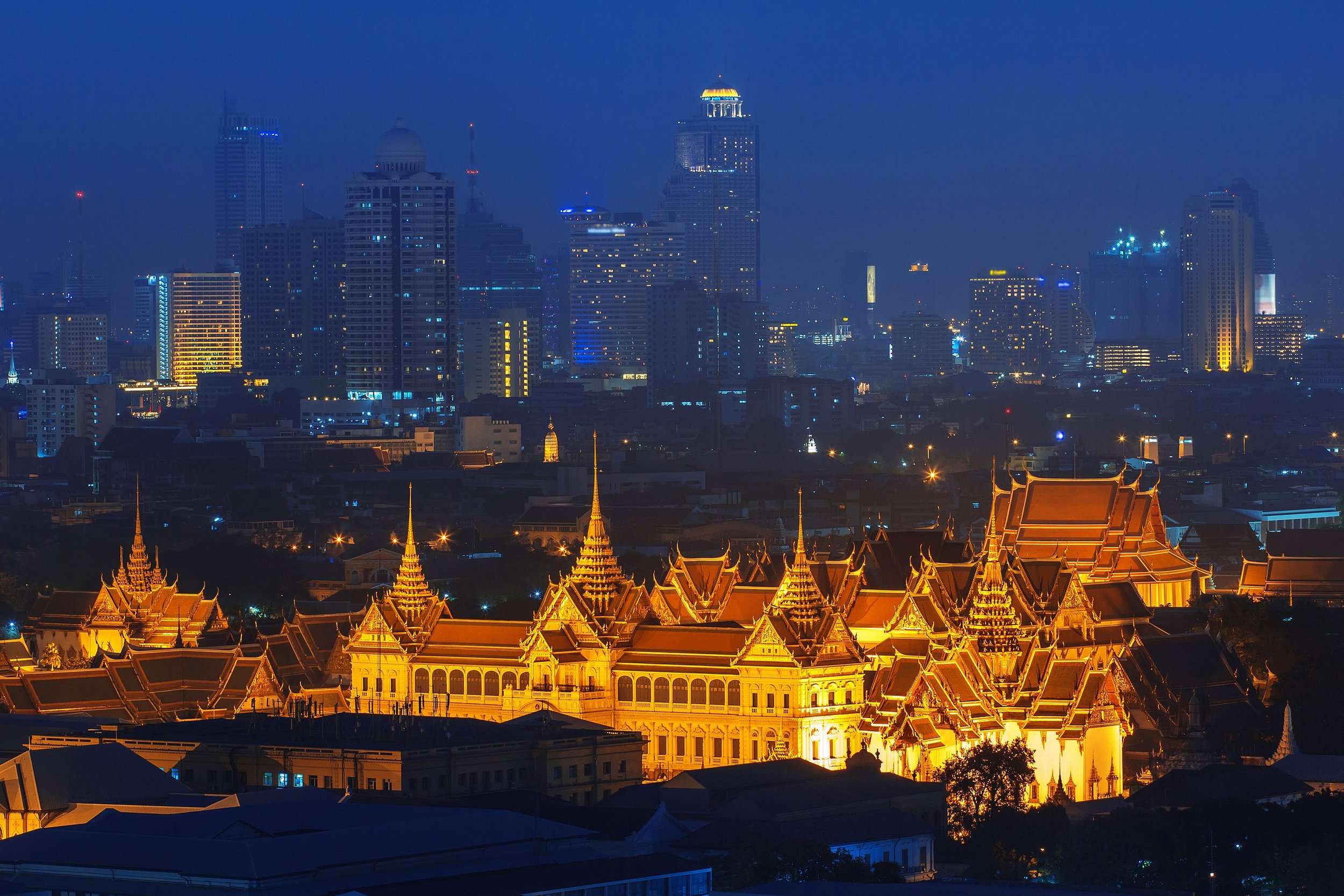Royal Cuisine
Grand Palace at night (Bangkok, Thailand)
The Royal Cuisine is an art form that represents the delicacy of Thai culture, and the preservation of this cuisine is significant to the dying Thai heritage.
"Royal cuisine" refers to food that originated from the ingenuity and creativity of high-ranking ladies of royal lineage, as well as noble women and their servants, within the Grand Palace, particularly during the reign of King Rama V (the current King is Rama X). When the inner palace was left abandoned at the end of his reign, the traditional recipes spread to the palaces of the royal lords and the estates of noble lords, as their female relatives left to live with their royal relatives, and to noble women who married out of the Grand Palace.
The important characteristic of Royal Cuisine, in addition to the basic traits shared with ordinary food, is the emphasis on using fresh and high-quality ingredients, along with complex and delicate cooking techniques that require significant time and effort from multiple individuals. This results in food that is exquisitely crafted with a gentle and not overly intense taste. One unique aspect of this cuisine is its, “rounded”, balance of the five tastes: sour, sweet, savory, salty, and spicy.
The other important characteristic that differentiates Royal Cuisine from ordinary food is its use of ingredients, which are combined in a variety of dishes. During the reign of King Rama V, at least seven types of dishes were served, including steamed rice, a main dish, curry, soup, dipping sauce/paste, vegetable dish/side, and dessert.
The food of the palace differs from the food of the commoners in that it must be served as a set, whether inside or outside the palace, or the noble estates. The food must be served on trays, whether they are wood or precious metal trays, according to the rank and title of the consumer. For an example: The food for the King would be cooked in a well-guarded Royal inner-palace-kitchen (only females are allowed to live inside the inner palace), portioned into individual golden bowls or traditional five-coloured gold gilded ceramic bowls on a gold tray, wrapped in white silk (red silk is for drinks), and sealed with wax, and then escorted up to the hall by female guards, The seals are then broken in front of the King and his food taster before serving.
Tray wrapping for high rank royalties is a well-guarded tradition that has been practiced for centuries
One of the biggest challenges in recreating Royal Thai Cuisine, in a restaurant setting, is cultural differences. Royal cuisine is incredibly complex and requires a high level of attention and understanding from both the cooks and the patrons. It is not simply a matter of following a recipe, but rather a delicate balance of flavors and textures that requires a deep understanding of the ingredients and techniques involved.
The Royal Cuisine is an art form that represents the delicacy of Thai culture, and preserving this cuisine is significant to the dying Thai heritage. Growing up in Thailand, side dishes were arranged on a tray or plate, including a bowl of spicy curry, a plate of stir-fried sweet/salty meat, a little plate of salad with meat or fried egg, a bowl of soup, stir-fried vegetables with meat, and a dipping sauce, along with steamed rice. The menu planning changes based on the main dish, usually curry. For example, if the curry is milder, then the stir-fry would be spicier, or if the rest of the dishes are milder, then the soup would be a little spicier than usual. Whether dried fish, salted eggs, and various salted fish require a sauce that is more sour than salty or the accompaniment is grilled or fried fish that lacks flavour, the sauce must have a balanced taste of sourness, saltiness, and sweetness to match with vegetables and accompaniments. Raw vegetables require a thick sauce, while boiled, stir-fried, and pickled vegetables need a clear sauce. The cook must pay attention to the accompanying food in menu planning for royal cuisine, ensuring that each dish neutralizes or tones down the intensity of the other dishes. All of these dishes are eaten together with a spoon and fork or by hand, while "keeping the rice clean". Thais do not pour everything on the rice or eat in courses.
Spicy & Sour Prawn (centre), Top to Clockwise: Rice, Green Curry, Asparagus & Prawn, Garlic & Pepper Pork, Beef Salad, Fish Sauce & Garlic & Chilli Dipping Sauce
In conclusion, while many restaurants advertise "Royal Cuisine" in Canada, it is impossible to recreate the authenticity and complexity of Royal Thai cuisine in a typical restaurant setting. The challenges rest on the patron’s understanding of cultural nuances, the cook’s mastering the intricate techniques and knowledge of menu planning including sourcing ingredients to make this possible.
A set of Traditional five-coloured gold gilded ceramics bowls on wooden trays




